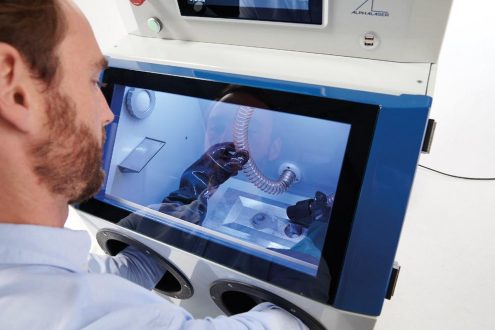
Interferometry in the palm of your hand
This is possible due to the fact that molecular bindings are always in a state of oscillation. The infrared light interacts with those bindings and gets them to an excited state. The energy levels and thus the amount of energy needed for such a transition are unique for the respective atoms of the molecule, meaning only light of certain wavelengths is absorbed. By looking at the spectrum, i.e. the intensities of light plotted over the wavelength, samples can be analyzed qualitatively and quantitatively.
As infrared spectroscopy does not require sample preparation and measurements only take about one second, it is easy to use for the operator. Furthermore, being a contactless and non-destructive technique, IR spectroscopy is low-maintenance, robust and hygienic. This allows accurate measurements while the sample is preserved and still usable.
How FT-IR works
An important and widespread technique for wavelength dependent IR measurement is Fourier Transform InfraRed (FT-IR) spectroscopy. A Michelson Interferometer is one approach to distinguish the light intensity at different wavelengths:
A dichroic mirror divides the light, one part of it is directed to a fixed mirror, the other part to a movable one. Both beams are reflected back to the beam splitter where they interfere with each other on their way towards an Indium Gallium Arsenide (InGaAs) photodiode. As the movable mirror oscillates, its position is monitored with a semiconductor laser. This information and the interference pattern measured by the diode is finally translated into a spectrum using Fourier Transform. Hence, the name Fourier Transform Infrared spectroscopy.
Why FT-IR saves resources
The compound material InGaAs, especially extended InGaAs with sensitivity up to 2.5 µm is a challenging raw material to grow due to a lattice mismatch between the optically active InGaAs and the substrate which can lead to crystal defects. Due to this, the smaller the active area required for the detector, the higher the production yield per wafer and the lower the material cost. As the FT-IR engine merely requires an InGaAs diode, it can be more cost effective than diffraction spectrometers with comparable characteristics.
Applications for FT-IR
The optical interferometer is the biggest part of such a device, making most FT-IR spectrometers bulky bench-top instruments. By using our own unique MEMS technology, Hamamatsu have reduced the size so the whole device fits on a palm, enabling interferometry within handheld systems.
In order to achieve optimum optical characteristics despite minaturisation, a large 3mm dia. movable mirror ensures high sensitivity upto 2500nm, equivalent to tabletop devices.
Additionally, the outstanding resolution and the great signal-to-noise ratio ensure that the FT-IR engine is suitable for sophisticated tasks such as
Environmental monitoring in the field
Ingredient analysis of agricultural products
Quality control in factory production
Food or plastic sorting at the store
Point of care testing for human health at home
Company image Hamamatsu Photonics Deutschland GmbH
Hamamatsu Photonics is the Japanese manufacturer of optoelectronic detectors, light sources and systems. The company was founded in 1953 in the city of Hamamatsu City and is still located there today for research and production. Hamamatsu Photonics is one of the world’s leading innovators in photonics. Hamamatsu Photonics develops and produces components across the entire spectrum of light-based technologies and is a leading high-tech supplier to a wide range of industries including chemical analysis, medical, automotive, security, X-ray and sensor technology. In the field of systems, Hamamatsu Photonics manufactures a wide range of image processing systems used in life sciences, digital pathology, semiconductor manufacturing, process control and basic research. Hamamatsu Photonics Deutschland GmbH, based in Herrsching am Ammersee since 1986, employs over 100 people and, next to Germany, also serves the following countries: Bulgaria, Denmark, Greece, Israel, Croatia, Montenegro, Netherlands, Austria, Poland, Romania, Slovakia, Czech Republic, Turkey and Hungary.
The Managing Director is Dr. Reinhold Guth.
Hamamatsu Photonics Deutschland GmbH
Arzberger Str. 10
82211 Herrsching am Ammersee
Telefon: +49 (8152) 375-0
Telefax: +49 (8152) 375-199
http://www.hamamatsu.com
Sales Engineer Analytical
Telefon: +49 (8152) 375-116
Fax: +49 (8152) 375-111
E-Mail: cwoehnl@hamamatsu.de
Public Relations
Telefon: +49 (8152) 375-185
Fax: +49 (8152) 375-199
E-Mail: rfritsch@hamamatsu.de
![]()





